State of Manufacturing 2025: When Manufacturing Wins, America Wins
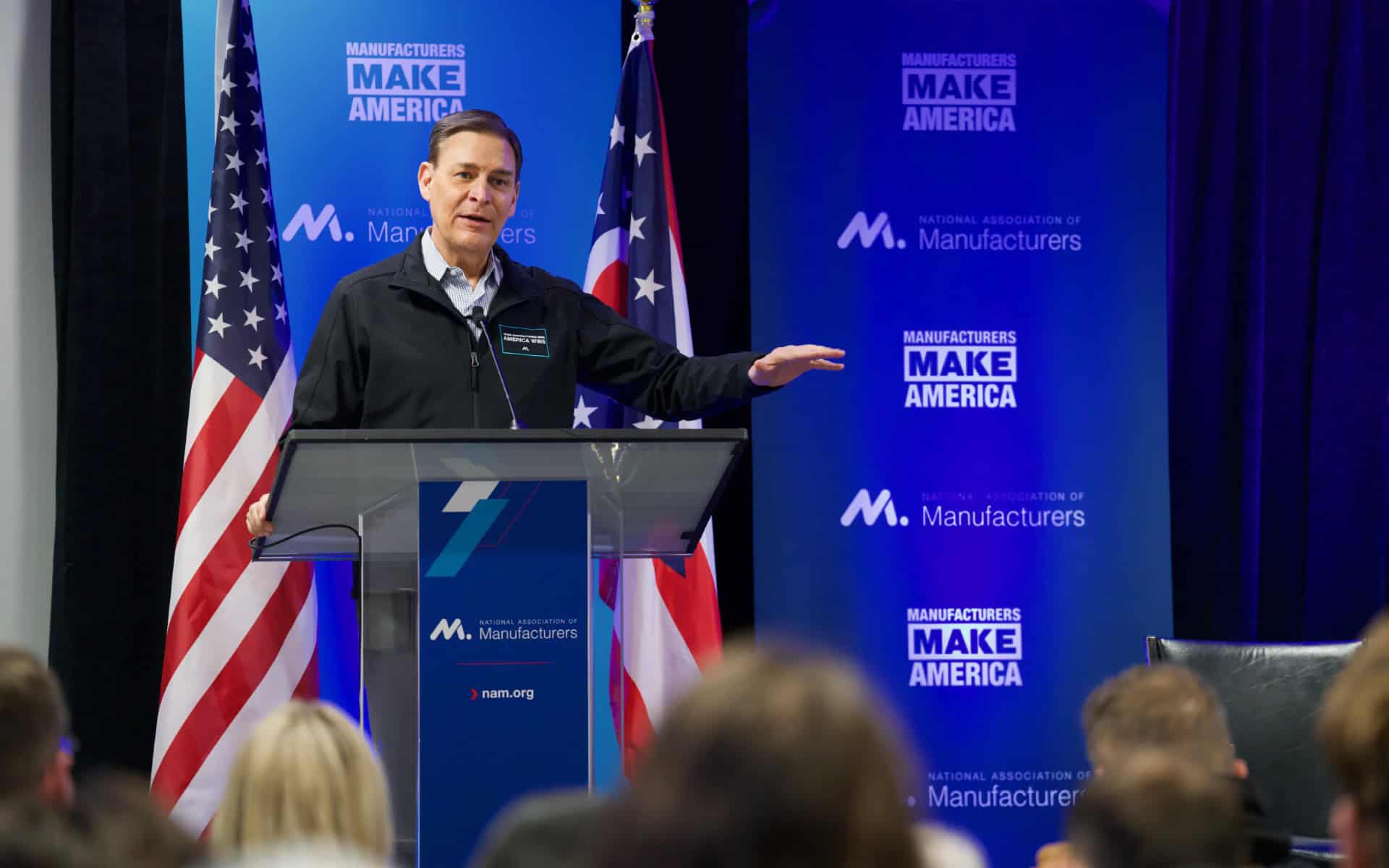
“Manufacturing in the U.S. has momentum”—and to keep it going, manufacturers will need to push, NAM President and CEO Jay Timmons said Tuesday in the NAM’s annual State of Manufacturing Address.
What’s going on: Speaking to an audience of manufacturers and congressional and state officials at Armstrong World Industries in Hilliard, Ohio, Timmons, who was joined by NAM Board Chair and Johnson & Johnson Executive Vice President and Chief Technical Operations & Risk Officer Kathy Wengel, emphasized the “defining moment” for the industry and said that for manufacturing, “what happens next really matters.”
- “Uncertainty is the enemy of investment,” he told the crowd. “Manufacturing is a capital-intensive industry. We make decisions months and years in advance. … That’s why we need certainty. We need a clear, actionable, multistep strategy from our government—one that says, ‘We want you to invest here, hire here and succeed here.’”
- Timmons’ annual speech kicked off the NAM’s 2025 Competing to Win Tour, starting with a whirlwind four-states-in-four-days tour of manufacturing facilities, schools, government offices and more.
- “In Ohio, manufacturers have thrived because our leaders have taken decisive actions to keep our industry competitive,” Ohio Manufacturers’ Association President Ryan Augsburger said at the kickoff event. But now, “manufacturers across Ohio and the nation are facing critical challenges, from tax uncertainty, project delays and workforce shortages to supply chain vulnerabilities and price pressures that threaten our ability to grow. … These issues cannot wait.”
What manufacturing needs: Certainty from the federal government should come in several forms, Timmons said, including the following:
- Preserving tax reform: The 2017 tax reforms were “rocket fuel” for manufacturing in America—but key provisions have expired and others are scheduled to sunset. Congress must bring them back and improve and extend the package. “Every day that Congress delays because of process and politics, manufacturers face rising uncertainty, delayed investments and fewer jobs,” said Timmons.
- Regulatory clarity and consistency: Manufacturers today spend a total of $350 billion just to comply with regulations. “Commonsense regulation is critical to American manufacturers to continue to innovate, to compete against foreign manufacturers and to improve the lives of American citizens,” Austin So, general counsel, head of government relations and chief sustainability officer for Armstrong World Industries, told the crowd.
- Permitting reform: President Trump’s lifting of the liquefied natural gas export permit ban was a start, but to reach our full potential as energy leader, we must require “federal agencies to make faster decisions and reduc[e] baseless litigation,” said Timmons.
- Energy dominance: “America should be the undisputed leader in energy production and innovation. But … we are seeing opportunities for energy dominance fade in the face of a permitting process that takes 80% longer than other major, developed nations,” Timmons said, adding that we must cut red tape, require federal agencies to make faster decisions and reduce meritless litigation.
- Workforce strategy: By 2033, manufacturing faces a shortfall of 1.9 million manufacturing employees, Timmons said. To fill those positions, the sector needs a “real workforce strategy,” one that includes apprenticeships, training programs and public–private partnerships.
- Commonsense trade policy: If President Trump continues to use tariffs, “we need a commonsense policy … that provides manufacturers with the certainty to invest” and “a clear runway to adjust,” according to Timmons.
State of manufacturing: “Manufacturing in the United States is moving forward,” Timmons said. “Like a press at full speed, like a production line firing on all cylinders, like the workers who show up before dawn and leave long after the job is done—manufacturing in the United States is driving us forward.” And Timmons added that now it’s time “to make America Great for Manufacturing Again.”
On the move: Following the speech, Timmons, Wengel and Augsburger joined state lawmakers, including state Sens. Kristina Roegner and Andrew Brenner, and local business leaders for a visit to the Ohio Statehouse for an event focused on the importance of tax reform for Ohio and its manufacturing sector.
- A recent NAM study found that, if key provisions of tax reform are allowed to expire, Ohio would risk losing 208,000 jobs and $18.9 billion in wages.
What’s at stake: Tax reform was transformational for Humtown Products, the Columbiana, Ohio–based family-owned sand cores and molds manufacturer, President and CEO Mark Lamoncha told the audience at the Ohio Statehouse tax event.
- “We have been at the forefront of 3D-printed manufacturing for years and have invested significantly in the machinery and equipment required, including the purchase of 3D printers—one of which can easily cost over $1 million,” he said.
- “Since the 2017 tax reform, Humtown has invested over $9 million in capital expenditures related to 3D printing and averages around $100,000 annually in R&D costs. Under the 2017 tax reform, we were able to deduct 100% of those costs, generating around $1.6 million in accelerated tax savings.”
- “That amount alone allowed us to purchase another 3D printer, fueling continued growth. That’s what tax certainty allowed us to do. But right now, that certainty is slipping away. As these provisions begin to expire, our tax burden is increasing.”
Creators Wanted: The group also fit in a stop at Columbus State Community College, which serves approximately 41,000 students, to visit with students in the semiconductor and mechanical drive classes.
The last word: The NAM recently “stood shoulder-to-shoulder with congressional leaders—delivering a clear, urgent message on tax reform” and is “driving the agenda on regulatory certainty, on energy dominance, on permitting reform, health care and workforce development,” Wengel told the audience. “The NAM is not waiting for Washington to act; we are making sure Washington acts for you, for manufacturers.”
- Added NAM Executive Vice President Erin Streeter: “The NAM is on [these issues], and we’re going to keep fighting, as we do every day with the right leaders, the right strategies and the right vision for the future.”
Manufacturers: AI Regulations Should Support Innovation and U.S. Leadership
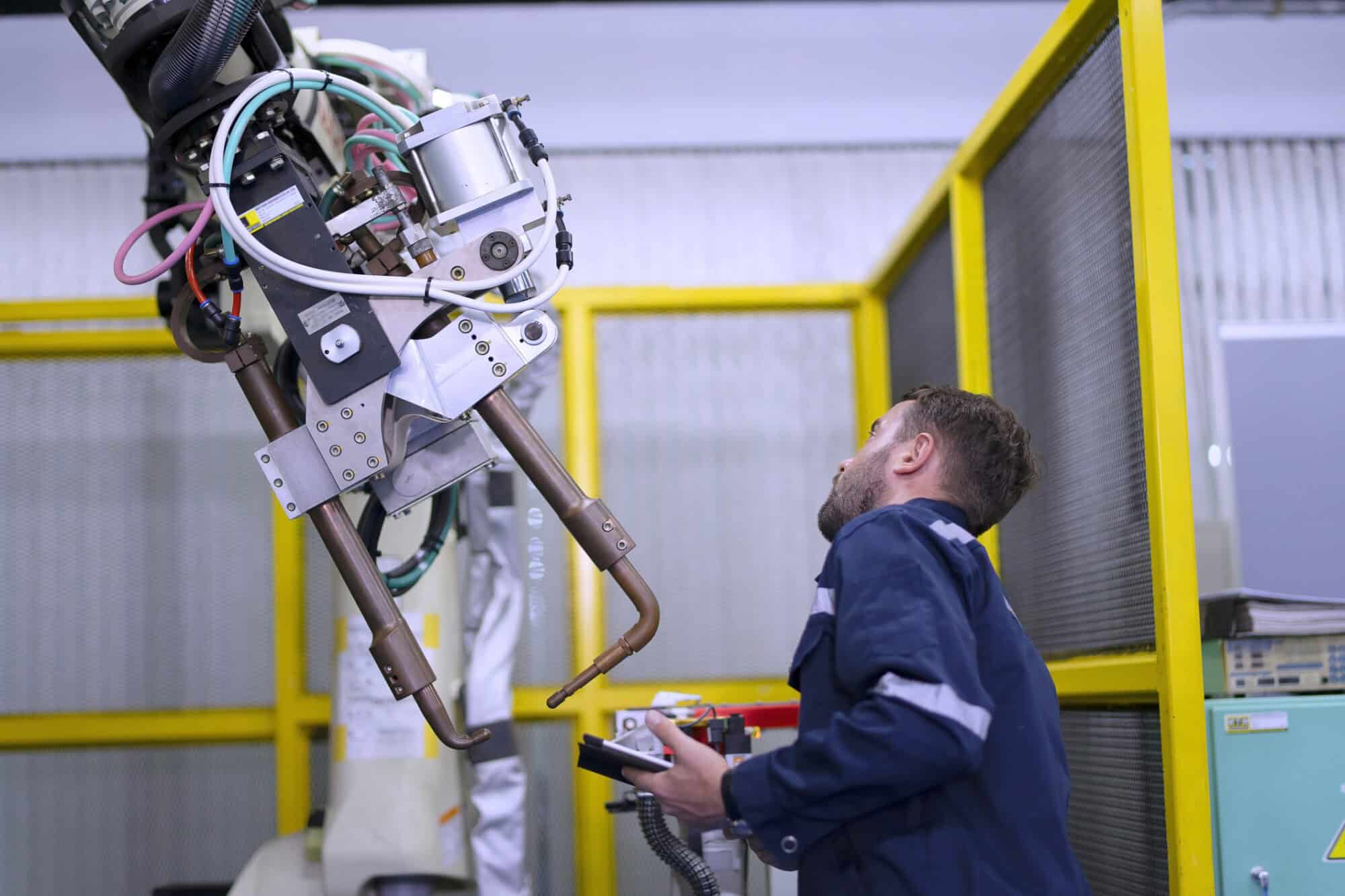
The introduction of artificial intelligence has been a boon to manufacturing, and the technology will continue to have a positive impact—as long as regulations are “right-sized,” manufacturers told Congress this week.
What’s going on: “Manufacturers are utilizing AI in myriad ways on the shop floor and throughout their operations,” the NAM told the House Subcommittee on Commerce, Manufacturing and Trade in a statement for the record at Wednesday’s hearing, where data was cited.
- “The diverse use-cases of AI in manufacturing suggest a need for a cautious regulatory approach to this groundbreaking technology: one that supports innovation and U.S. leadership in AI while providing context-specific, risk-based, right-sized rules of the road for manufacturers,” the NAM said.
- Giving testimony at the hearing, Siemens USA President and CEO and NAM Board Member Barbara Humpton discussed the many benefits of using AI in manufacturing and emphasized the need to ensure that AI regulations include “targeted” rather than “overly broad” definitions.
Industrial vs. consumer-focused AI: First, it’s important to distinguish between industrial and consumer-facing AI, Humpton told the subcommittee members.
- “Industrial AI is different from consumer AI,” she said. “Industrial AI uses controlled data from the manufacturing environment to help manufacturers create business value. Think better products, more efficient operations, a more prepared workforce. … AI will enable all companies—from startups to small and medium enterprises to industrial giants—to thrive in this new era of American manufacturing.”
- In written testimony, she added that “the core distinction of industrial AI is that it is trained on highly monitored data from sensors and machines, providing a more reliable foundation for training AI models.”
Simple, singular and targeted: Regulation of AI should be undertaken with a light touch and following a full accounting of on-the-books laws to prevent duplicative and/or contradictory rules, the NAM said.
- “[P]olicymakers should always review existing laws and regulations before enacting new ones, because most uses of AI correspond to tasks and objectives that industry has faced for a long time and that are thus highly likely to have already been addressed by existing laws and regulations,” said the NAM, which also referenced its first-of-its-kind AI report, “Working Smarter: How Manufacturers Are Using Artificial Intelligence,” released last May.
- “Similarly, policymakers must right-size any compliance burden associated with AI regulation,” the NAM continued. “The ubiquitous use of AI throughout modern manufacturing, as well as manufacturing’s dependence on innovation, underscore the need for rules that enable rather than hinder manufacturers’ development and adoption of AI systems.”
Protect without hindering: Congress “must advance industrial AI by prioritizing strong rules for digital trade, especially to include strong protections for source code and algorithms,” Humpton went on in her written testimony. “We encourage policymakers to build upon the success of previous U.S.-led efforts to protect intellectual property.”
- Legislators must also safeguard privacy and protect against baseless legal claims, the NAM said. “[I]t is … crucial that Congress take steps to maintain the privacy of personal data when utilized in AI contexts. … A federal standard should avoid a patchwork of state-level rules by fully preempting state privacy laws; it also should protect manufacturers from frivolous litigation.”
The last word: “The range and importance of uses of AI—transforming every aspect of the core of manufacturers’ operations—make it clear that AI has become integral to manufacturing,” said the NAM. “With the right federal policies, manufacturers in the U.S. will continue to devise new and exciting ways to leverage AI to lead and innovate and stay ahead of their global competitors.”
NAM Welcomes House Report on AI

Manufacturers support the policy recommendations laid out in the House of Representatives’ newly released report on artificial intelligence, the NAM said Tuesday.
What’s going on: The Bipartisan House Task Force Report on Artificial Intelligence contains AI-related recommendations for implementation by Congress.
- Drafted by the House AI Task Force—12 Republicans and 12 Democrats—the 273-page document “highlights America’s leadership in its approach to responsible AI innovation while considering guardrails that may be appropriate to safeguard the nation against current and emerging threats,” the task force’s co-chairs, Reps. Jay Obernolte (R-CA) and Ted Lieu (D-CA), wrote in a letter to House Speaker Mike Johnson (R-LA) and House Minority Leader Hakeem Jeffries (D-NY) at the beginning of the report.
The details: The task force report includes many recommendations that the NAM supports, including the following:
- Promote innovation: “As the global leader in AI development and deployment, the United States is best positioned to responsibly enable the potential of this transformative technology for all. To maintain this leadership and enable the U.S. economy to harness the full benefits of AI, policymakers should continue to promote AI innovation.”
- Safeguard against harm: “A thoughtful, risk-based approach to AI governance can promote innovation rather than stifle it.”
- Plan for power needs: “Planning properly now for new power generation and transmission is critical for AI innovation and adoption.”
- Develop an AI-ready workforce: “Successful collaborations between educational institutions, government and industries should effectively align education and workforce development with market needs and emerging technologies.”
- Protect privacy: Congress should “[e]nsure privacy laws are generally applicable and technology-neutral.”
- Make compliance feasible: Lawmakers should ensure that AI regulatory compliance is not unduly burdensome for small businesses
- Increase cooperation: Bolster collaboration between the government, industry and academia to boost innovation and expand markets.
NAM alignment: In May, the NAM released “Working Smarter: How Manufacturers Are Using Artificial Intelligence,” its own report on AI’s deployment in the manufacturing sector and an accompanying list of suggested policy actions for Congress to take.
- The NAM briefed legislators on its report in September.
Next steps: The NAM will work closely with policymakers in Congress and the incoming administration to bolster AI innovation in manufacturing, based on shared policy goals.
Additionally, manufacturers will continue to call on Congress to pass federal data privacy legislation that “preempt[s] state privacy regulations [and] resolve[s] conflicting requirements in different states”—an important issue for the use of AI where the House report does not prescribe a policy solution.
Lucid Revs Up the Domestic Graphite Supply Chain
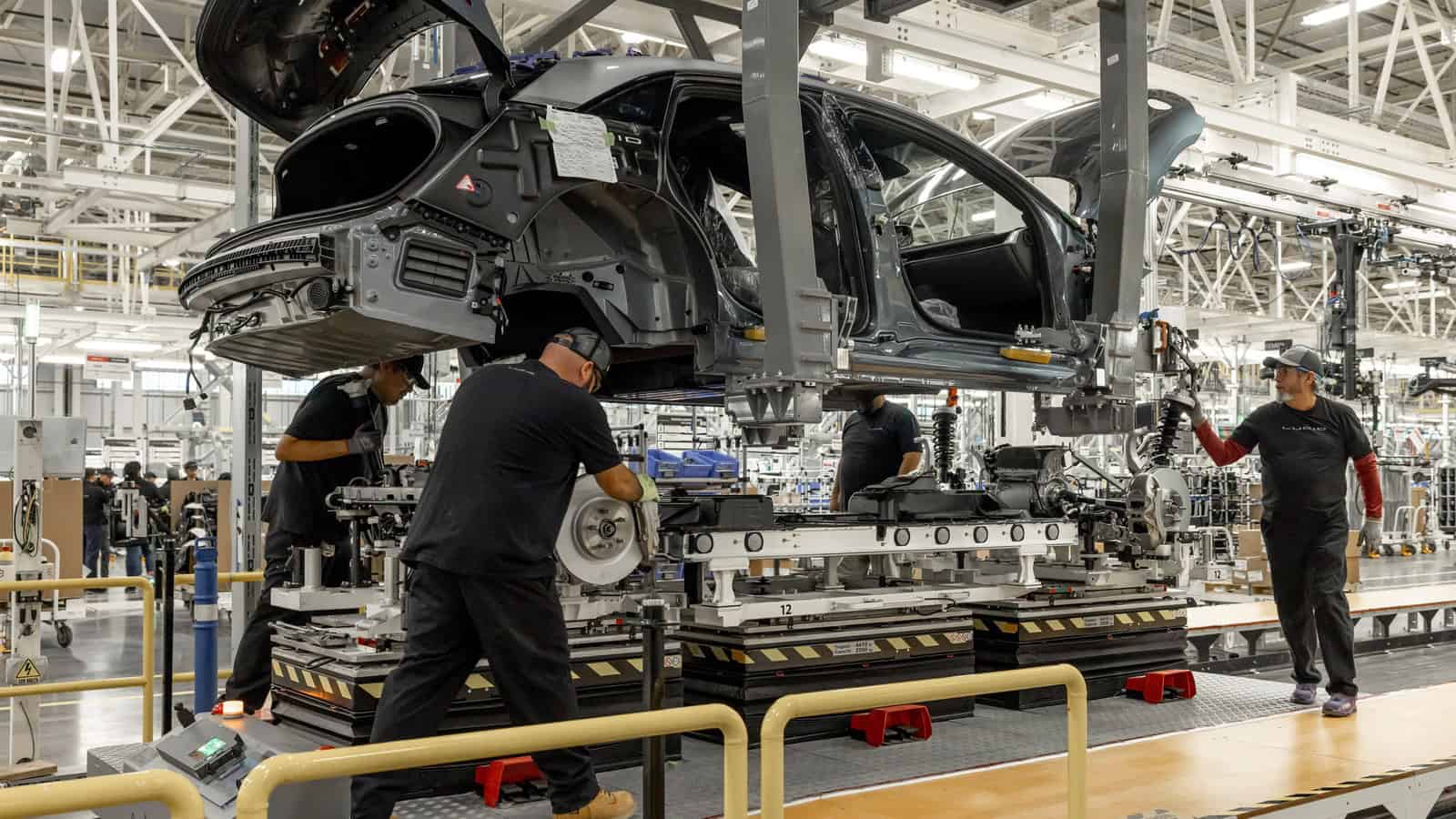
Lucid has already made one of the most energy-efficient cars on the market. Now the company is on a mission to strengthen supply chains for the critical materials powering its award-winning vehicles.
Supply chain warrior: The California-based electric vehicle manufacturer—whose 2025 Air Pure sedan is the first EV to achieve a milestone 5 miles of range per kilowatt of energy—recently reached an agreement with Alaskan mining exploration company Graphite One to purchase synthetic graphite for its vehicles’ battery packs.
- The deal, which goes into effect in 2028, is a crucial first step toward cementing a domestic supply chain of graphite, a mineral that makes up about half of every EV’s battery composition. EV batteries require both synthetic and natural graphite.
- “Today 100% of the graphite for batteries assembled in the U.S. comes from overseas,” said Lucid Motors Supply Chain Group Manager of Battery Raw Materials Michael Parton. “Building a robust domestic supply chain ensures the United States and Lucid will maintain technology leadership in this global race.”
Pandemic lesson: The global pandemic revealed the downside of depending on other nations for critical materials, and the importance of cultivating domestic sources instead.
- In 2020, “every company experienced major challenges when it came to shutdowns and global trade,” Parton said. “Having a domestic supply reduces production risk, accelerates response time and agility and lowers the need to carry higher levels of inventory.”
A midstream gap: When it comes to EV batteries and their supply chains, “much of the discussion is on localizing the bookends of the supply chain, the downstream battery production and the upstream mineral extraction,” Parton told us.
- Less discussed is the “midstream environment,” which comprises the precursor cathode active materials (P-CAM) and cathode active materials (CAM) stages. Materials used during these phases in the battery production process include critical minerals such as lithium, nickel and cobalt.
- The P-CAM market has been a difficult one to navigate, Parton added. For years, the P-CAM stage has been outsourced to countries with more cost-effective production. The problem: These countries also have less stringent environmental regulations than the U.S.
- “There’s limited investment announced [in the U.S.] in the refining and chemical conversion process at these stages, but it’s where the real need is,” Parton continued. “To promote localized sources of supply for mined and recycled minerals, there needs to be a domestic option for both P-CAM and CAM.”
A bipartisan issue: Lucid’s advocacy for a strong domestic supply chain has won bipartisan support in Congress.
- “There’s something in it for everyone when it comes to efficiency,” said Lucid Motors Senior Manager of International and Trade Policy Emily Patt, citing the environmental and self-sufficiency benefits of a resilient domestic supply chain.
What’s next: Lucid is expanding its vehicle lineup beyond the Air and the vehicle’s four trim levels.
- By the end of 2024, the company is scheduled to start production of the seven-passenger Lucid Gravity. The company has also teased an upcoming midsize platform, which is expected to start production in late 2026.
The grand vision: “The pursuit of efficiency drives Lucid as a company,” Patt said. “We’re not just making zero-emission cars; we’re committed to making the best use of the world’s resources to maximize the benefits for electrification and the planet.”
Manufacturer Sentiment Declines

Manufacturer sentiment fell in the third quarter of this year, according to the NAM’s Q3 2024 Manufacturers’ Outlook Survey, out Wednesday.
What’s going on: Results of the survey, which was conducted Sept. 5–20, reflect “preelection uncertainty,” NAM President and CEO Jay Timmons said—but also larger economic concerns.
- “The good news is that there is something we can do about it,” said Timmons. “We will work with lawmakers from both parties to halt the looming tax increases in 2025; address the risk of higher tariffs; restore balance to regulations; achieve permitting and energy security; and ease labor shortages and supply chain disruptions.”
Key findings: Notable data points from the survey include the following:
- Some 62.9% of respondents reported feeling either somewhat or very positive about their business’s outlook, a decline from 71.9% in Q2.
- A weaker domestic economy was the top business challenge for those surveyed, with 68.4% of respondents citing it.
- Nearly nine out of 10 manufacturers surveyed agreed that Congress should act before the end of 2025 to prevent scheduled tax increases on manufacturers.
- The overwhelming majority—92.3%—said the corporate tax rate should remain at or below 21%, with more than 71% saying a higher rate would have a negative impact on their businesses.
- More than 72% said they support congressional action to lower health care costs through the reform of pharmacy benefit managers.
The last word: “When policymakers take action to create a more competitive business climate for manufacturers, we can sustain America’s manufacturing resurgence—and strengthen our can-do spirit,” Timmons said.
- “This administration and Congress—and the next administration and Congress—should take this to heart, put aside politics, personality and process and focus on the right policies to strengthen the foundation of the American economy.”
NAM Emphasizes USMCA, Protecting Investors in Mexico Meetings

In high-level meetings with government, manufacturing and trade group leaders held in Mexico last week, the NAM hammered home a key message: For North American manufacturing to remain globally competitive, Mexico must protect investor holdings in the country.
What’s going on: During a jam-packed three-day visit to Mexico City, NAM President and CEO Jay Timmons and an NAM contingent met with top officials in the new Sheinbaum administration, as well as leadership at multiple agencies and associations.
- These included newly appointed Deputy Trade Minister Luis Rosendo Gutiérrez, the Business Coordinating Council (CCE), the Confederation of Industrial Chambers of Mexico (CONCAMIN), the Mexico Business Council (CMN), the National Council of the Export Manufacturing Industry (INDEX) and others.
What they said: The NAM’s main message at each gathering was the same: Companies investing in Mexico need assurance that their portfolios will be protected regardless of the fate of proposed judicial reforms in the country.
- The NAM also underscored the importance of the U.S.–Mexico–Canada Agreement, which is due for review in 2026, and the necessity of ensuring that the deal is upheld for all three parties.
- If its terms are respected, USMCA could help North American manufacturing outcompete China.
On China: This week, just days after his office’s meeting with the NAM, Gutiérrez announced that the Sheinbaum administration will seek U.S. manufacturers’ help to reshore—mainly from China—the production of some critical technologies (The Wall Street Journal, subscription).
- “We want to focus on supporting our domestic supply chains,” he told the Journal, adding that talks with U.S. companies are still in the informal stage.
The NAM says: “Manufacturing is at the heart of the USMCA,” said NAM Vice President of International Policy Andrea Durkin, who was part of the NAM group on the ground in Mexico. “The NAM intends to work to ensure that the agreement strengthens the competitiveness of manufacturers.”
New DOD Loan to Fund “Critical Technologies” Manufacturing

The Defense Department’s Office of Strategic Capital is now accepting applications for flexible direct loans to build, expand and/or modernize “critical technologies” facilities (Federal Register).
- It’s also seeking input from companies and trade associations on the Defense Department’s loan program, via a Request for Information open through Oct. 22 (Federal Register).
What’s going on: The OSC’s credit program, launched Sept. 30, aims “to attract and scale private capital in industries and technologies that are critical to America’s national and economic security,” according to the Defense Department. This is part one of the application process.
- The financing is geared toward manufacturers that must spend significantly on industrial or specialty equipment to create new assembly lines in existing facilities.
- The money is also intended to help them cover “soft” expenses, such as factory preparation and installation, associated with critical technology projects.
Why it’s important: “The funding from this program could benefit manufacturers of all sizes that are working to expand their businesses and product lines in critical areas of the economy,” said NAM Director of Energy and Natural Resources Policy Mike Davin.
- The OSC loans offer flexible terms, a U.S. Treasury-comparable interest rate, long repayment periods and deferred payments.
Who’s eligible: Manufacturers within the 31 “Covered Technology Categories”— which include advanced manufacturing, cybersecurity, battery storage and spacecraft—are encouraged to apply.
- There is no company-size or employee-number threshold or limit, and manufacturers with existing federal grants are eligible.
J&J: Price Controls, PBMs Problematic
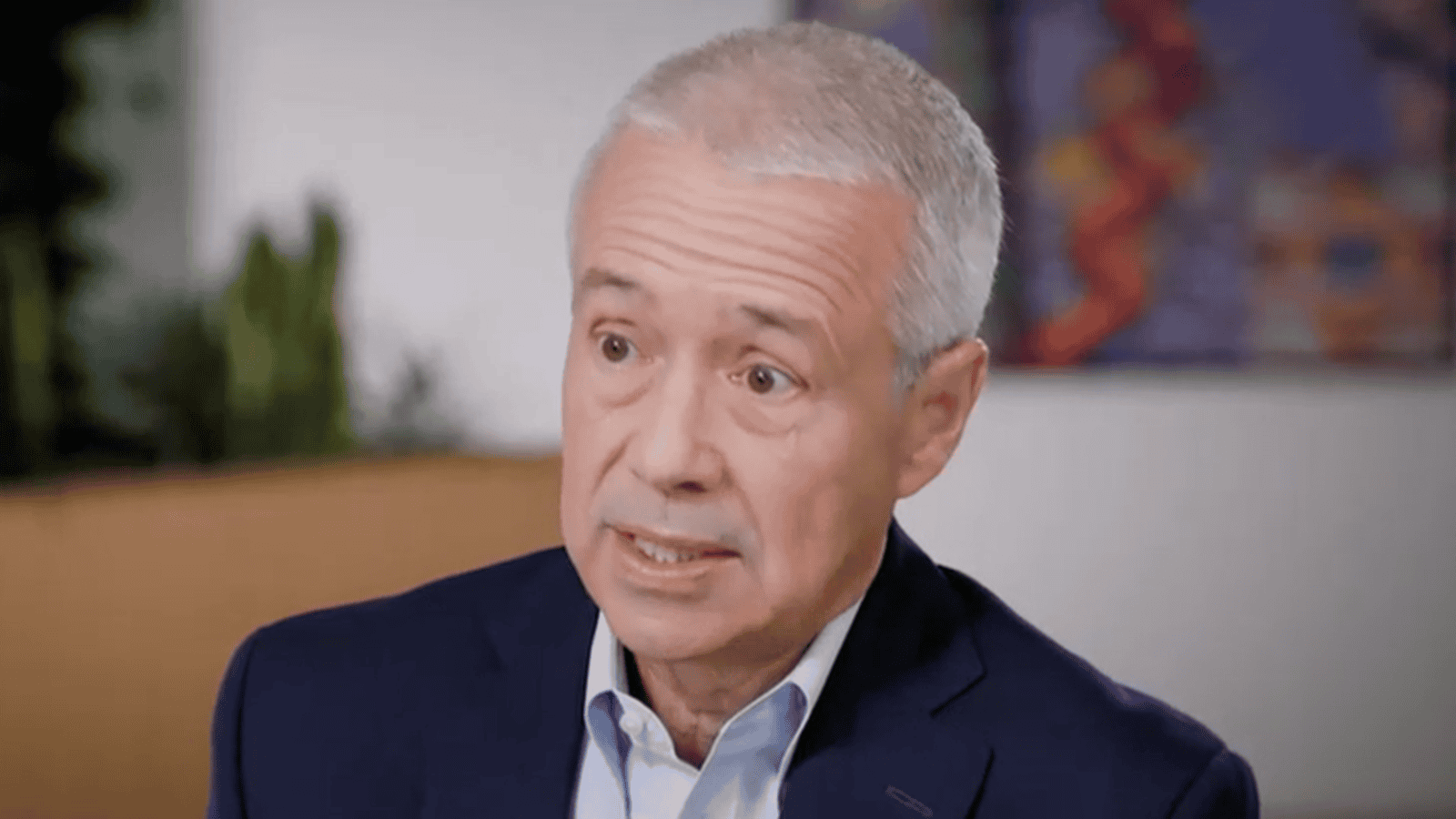
Drug price controls will “chill” critical innovation in pharmaceutical manufacturing and do nothing to address the underlying causes of high medication costs, Johnson & Johnson leaders said recently.
What’s going on: J&J Chairman and CEO Joaquin Duato and Executive Vice President and Chief Financial Officer Joseph Wolk told Bloomberg TV earlier this month that the pharmaceutical price controls mandated by the 2022 Inflation Reduction Act do a disservice to patients everywhere.
- “[T]he Inflation Reduction Act … is something that is misguided, and it’s going to chill innovation,” Duato told Bloomberg’s David Gura earlier this month. “When you chill innovation on investment in [research and development], then you have [fewer] cures.”
- The IRA gave the federal government authority to set prices for certain prescription medications in Medicare. In August, the Biden administration released the first 10 Medicare prescription drugs subject to those price controls, which go into effect in 2026.
- “I’d like to see a much more fact-based dialogue around the topic of drug pricing,” Wolk added. “About six years ago, Johnson & Johnson … was paying about 25% in discounts and rebates off [the] list price [of medications]. Today, that [figure is] 60%, yet the patients aren’t receiving the benefit of those discounts.”
The background: Pharmacy benefit managers are supposed to pass the manufacturer discounts they receive on to health plans and patients—but instead, they frequently pocket the discounts, the NAM has told Congress on several occasions.
- That’s one of several problematic business practices Congress must end by enacting comprehensive PBM reform, the NAM has said.
- Such legislation would do far more to benefit consumers than capping drug prices.
Cause and effect: The result of price controls will be fewer breakthrough cures and treatments for patients suffering from various illnesses, J&J told Bloomberg TV.
- “The number of medicines that will be there will be [lower], just because [fewer] investors would be putting money into developing new medicines,” Duato continued. “It’s going to be less attractive for investors to put money there.”
- And as Wolk said in another Bloomberg segment: “Investing in R&D, prioritizing R&D years in advance for [a drug] that may happen 10 years down the road is critically important.”
What should be done: If Congress truly wants to help patients with the cost of medications, it must focus on “the middlemen who are really driving up prices: pharmacy benefit managers,” NAM President and CEO Jay Timmons said recently.
NAM-Supported Bills Clear House Committee
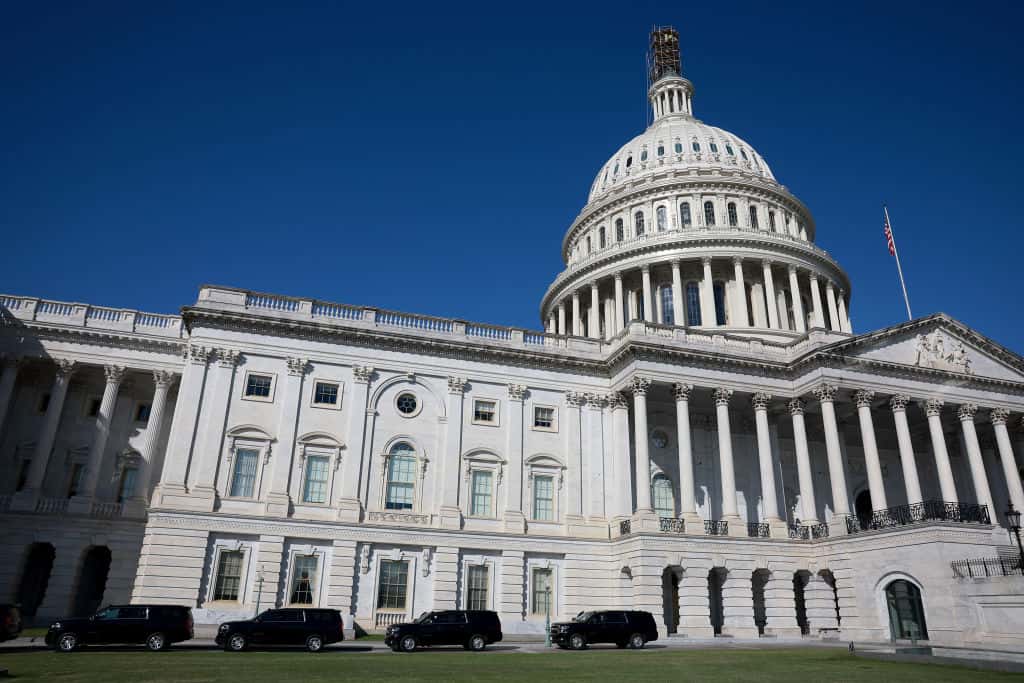
The NAM this week advocated the passage of two pieces of manufacturing-critical legislation, successfully driving the agenda of a Wednesday House Energy and Commerce Committee markup.
What’s going on: The committee—with the NAM’s strong support—approved two bills that address longstanding manufacturing priorities:
- A congressional resolution disapproving of the Environmental Protection Agency’s harmful PM2.5 rule
- A bill instituting important pharmacy benefit manager reforms
Reversing an unworkable PM2.5 standard: The EPA announced a new, more restrictive particulate matter standard in February, reducing allowable levels from 12 micrograms per cubic meter of air to 9 micrograms—despite a standard of 9 being “essentially background levels in some of the country,” as the NAM has pointed out.
- “Manufacturers have sharply reduced particulate matter emissions, or PM2.5; as a result, industry in the United States has some of the cleanest and most efficient operations in the world,” NAM Vice President of Domestic Policy Chris Phalen told the committee.
- “Now, the vast majority of emissions are from sources well outside of our control, with fires, dirt roads and other nonpoint sources accounting for 84% of PM2.5 emissions,” Phalen continued. “[T]he EPA’s rule will make it more difficult for states to issue permits for the construction of new facilities or expansions of existing factories.”
- The committee’s PM2.5 resolution, offered under the Congressional Review Act, seeks to overturn the EPA’s unworkable standard.
Reforming PBMs: PBMs are unregulated middlemen whose business practices drive up health care costs for manufacturers and manufacturing workers.
- “By applying upward pressure to list prices that dictate what patients pay at the pharmacy counter, pocketing manufacturer rebates and failing to provide an appropriate level of transparency about their business practices, PBMs increase health care costs at the expense of all patients in America,” NAM Vice President of Domestic Policy Charles Crain said.
- Provisions in the NAM-supported Telehealth Modernization Act would increase transparency into PBMs’ business practices and delink their compensation from medicines’ list prices.
The last word: “Manufacturers commend the Energy and Commerce Committee for approving these important bills, which will reduce costs and enhance growth at manufacturers across the country—allowing our industry to continue to create jobs here at home and drive U.S. competitiveness on the world stage,” said NAM Managing Vice President of Policy Chris Netram.
NAM Launches Ad Campaign for PBM Reform

The NAM has launched a new wave of ads in D.C. and nine states, extending its seven-figure campaign urging policymakers to reign in pharmacy benefit managers, underregulated middlemen who drive up the costs of prescription medications for manufacturers and manufacturing workers.
A quick refresher: PBMs sit in the middle of the health care industry, negotiating with employer health plans, insurers, biopharmaceutical manufacturers, pharmacies and other players to determine what prescriptions employees can access and what they pay for them. While their job is ostensibly to reduce the costs of medicines, often they do the exact opposite.
- PBMs have been found to steer patients toward pricier options, inflict steep mark-ups and hidden fees and even pocket large portions of the rebates that biopharmaceutical manufacturers intend for American workers and their families.
NAM in action: The NAM has been a staunch voice supporting PBM reform on Capitol Hill, recently laying out manufacturers’ concerns for the House Committee on Oversight and Accountability.
- The committee conducted its third hearing on PBM overreach in July, when it also released a highly critical report on PBMs that echoed many of the NAM’s concerns.
- In addition, the NAM is supporting several key measures to increase oversight of PBMs’ business models and reform their pricing strategies, including the DRUG Act and the PBM transparency provisions in the Lower Costs, More Transparency Act.
What Congress should do: The NAM is advocating for three major reforms to the PBM system, including:
- Increasing transparency in PBMs’ business models, including how their compensation influences health care decisions and how their policies dictate a medicine’s cost and formulary placement;
- Rebate pass-through, which will ensure health care savings are passed directly to manufacturers and their workers rather than being pocketed by PBMs; and
- Delinking PBMs’ compensation from a medicine’s list price, removing their incentive to put upward pressure on list prices to maximize their own profits.
Benefits for all: The NAM is calling on Congress to enact these reforms in the commercial insurance market, not just in government programs like Medicare and Medicaid, so that all Americans can enjoy lower-cost health care benefits.
What to watch: The NAM is calling on Congress to act on this issue during the lame-duck session following the election.